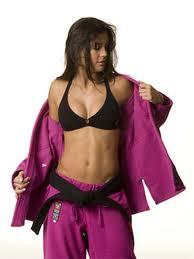Eventually, in Japan many different variations of the art (Jiu-Jitsu) took shape, including Karate, Aikido, and Judo. But these arts were missing essential pieces of what the complete art of Jiu-Jitsu originally held. Soon the day of the Samurai came to an end, the gun replaced the sword, and new sportive ways to practice martial arts were developed. This lack of reality created years of confusion in the martial arts community, a confusion that legendary Bruce Lee would later refer to as the 'classical mess'.
The 'sport arts', such as Judo and Kendo were wonderful in the way of offering their practitioners a safe way to realistically train the techniques of their system, but often limited their practitioners with too many rules to maintain effectiveness as a combative style. The more traditional combat schools were simply practicing techniques no longer suitable for modern day combat, and with no way to safely test them,
practicing these arts became like swimming without water. It wasn't until the sport art of Judo and the combat art of Jiu-Jitsu were introduced to the Gracie family in Brazil that the real art of Jiu-Jitsu would be brought to life again. Japanese Jiu-Jitsu (practiced as Judo) was introduced to the Gracie family in Brazil (@ 1915) by Esai Maeda, who is also known as Conde Koma. This name came about when Maeda was in Spain (1908).
While in Spain, Maeda, having some financial troubles, used the Japanese verb "komaru", meaning to be in trouble, to describe himself. Maeda decided this didn't sound right, so he dropped the last syllable and changed it to "koma." The word "conde" comes from the Spanish language, meaning "Count." Later in his life, Maeda would be given the Brazilian title of "Conte Comte," or Count Combat.
Maeda was a champion of Judo and a direct student of its founder, Jigoro Kano, at the Kodokan in Japan. He was born in 1878, and became a student of Judo in 1897. In 1904 Maeda was given the opportunity to travel to the United States with one of his teachers, Tsunejiro Tomita. While in the U.S.
they demonstrated the art of Judo for Theodore Roosevelt at the White House, and for cadets at the West Point Military Academy. This is an exert from Roosevelt's letters to his children on wrestling and Jiu-Jitsu (note the spelling is Jiu-Jitsu, not Jujutsu due to the fact that it is before 1950):
White House, Feb. 24, 1905.
Darling Kermit:
"... I still box with Grant, who has now become the champion middleweight wrestler of the United States. Yesterday afternoon we had Professor Yamashita (Yamashita was Roosevelt's Jiu-Jitsu instructor before Meada and Tomita had arrived there in the U.S.) up here to wrestle with Grant.
It was very interesting, but of course jiu jitsu and our wrestling are so far apart that it is difficult to make any comparison between them. Wrestling is simply a sport with rules almost as conventional as those of tennis, while jiu jitsu is really meant for practice in killing or disabling our adversary. In consequence, Grant did not know what to do except to put Yamashita on his back, and Yamashita was perfectly content to be on his back.
Inside of a minute Yamashita had choked Grant, and inside of two minutes more he got an elbow hold on him that would have enabled him to break his arm; so that there is no question but that he could have put Grant out. So far this made it evident that the jiu jitsu man could handle the ordinary wrestler.
But Grant, in the actual wrestling and throwing was about as good as the Japanese, and he was so much stronger that he evidently hurt and wore out the Japanese. With a little practice in the art I am sure that one of our big wrestlers or boxers, simply because of his greatly superior strength, would be able to kill any of those Japanese, who though very good men for their inches and pounds are altogether too small to hold their own against big, powerful, quick men who are as well trained."


